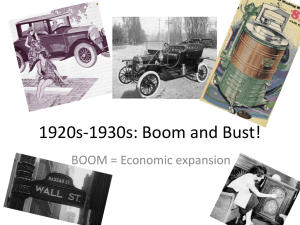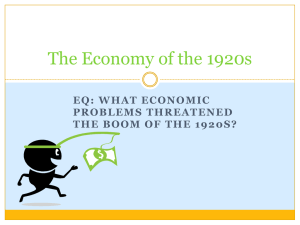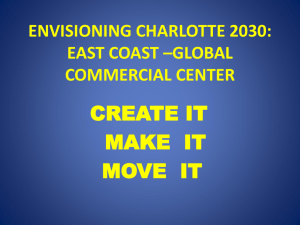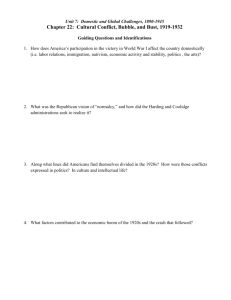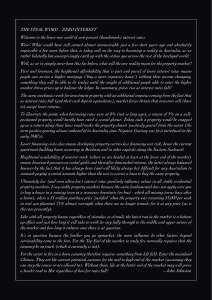Boom, Gloom, and Excess - The International Economy
advertisement
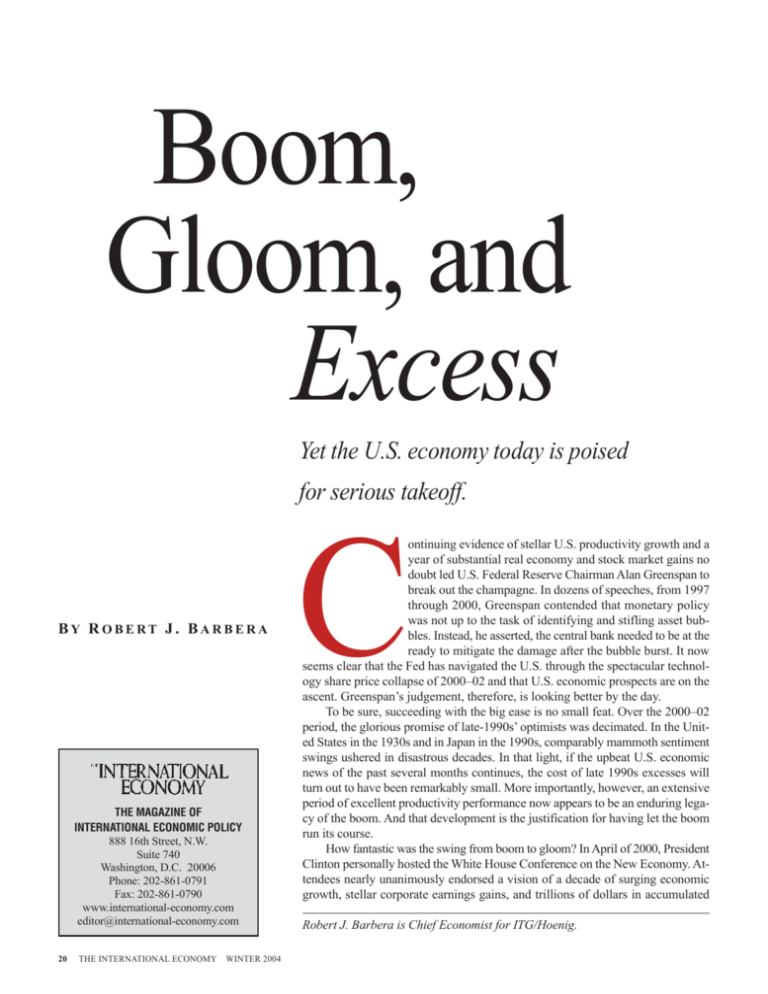
Boom, Gloom, and Excess Yet the U.S. economy today is poised for serious takeoff. BY ROBERT J. BARBERA THE MAGAZINE OF INTERNATIONAL ECONOMIC POLICY 888 16th Street, N.W. Suite 740 Washington, D.C. 20006 Phone: 202-861-0791 Fax: 202-861-0790 www.international-economy.com editor@international-economy.com 20 THE INTERNATIONAL ECONOMY WINTER 2004 C ontinuing evidence of stellar U.S. productivity growth and a year of substantial real economy and stock market gains no doubt led U.S. Federal Reserve Chairman Alan Greenspan to break out the champagne. In dozens of speeches, from 1997 through 2000, Greenspan contended that monetary policy was not up to the task of identifying and stifling asset bubbles. Instead, he asserted, the central bank needed to be at the ready to mitigate the damage after the bubble burst. It now seems clear that the Fed has navigated the U.S. through the spectacular technology share price collapse of 2000–02 and that U.S. economic prospects are on the ascent. Greenspan’s judgement, therefore, is looking better by the day. To be sure, succeeding with the big ease is no small feat. Over the 2000–02 period, the glorious promise of late-1990s’ optimists was decimated. In the United States in the 1930s and in Japan in the 1990s, comparably mammoth sentiment swings ushered in disastrous decades. In that light, if the upbeat U.S. economic news of the past several months continues, the cost of late 1990s excesses will turn out to have been remarkably small. More importantly, however, an extensive period of excellent productivity performance now appears to be an enduring legacy of the boom. And that development is the justification for having let the boom run its course. How fantastic was the swing from boom to gloom? In April of 2000, President Clinton personally hosted the White House Conference on the New Economy. Attendees nearly unanimously endorsed a vision of a decade of surging economic growth, stellar corporate earnings gains, and trillions of dollars in accumulated Robert J. Barbera is Chief Economist for ITG/Hoenig. Amy Miller-Szanto, Descent from the Center, oil on canvas, 66 inches by 52 inches. WINTER 2004 THE INTERNATIONAL ECONOMY 21 BARBERA Fed Chairman Greenspan’s Judgement At crucial moments, the system depends upon an artful central banker, one who knows what he needs to do and when he needs to do it. Greenspan’s judgement, therefore, is looking better by the day. —R. Barbera government budget surplus—all compliments of the ongoing information technology revolution. In rapid-fire succession, the collapse of NASDAQ, the 2001 recession, the evaporation of hundreds of billions of dollars’ worth of corporate earnings, and the spectacular swing to deficit from surplus for federal and state governments laid waste to this brave new world. The conventional wisdom, in turn, came full circle. Financing technology startups and spending on high technology capital goods came to be associated with wasteful investment, fanciful profit projections, and ultimately fraud. Lengthening unemployment lines, disappearing 401(k)s, and growing government red ink were all linked to the boom’s excesses. As a consequence, debate about the late 1990s boom and the 2000–02 bust is now centered upon who is to blame. Nearly everyone, it seems, agrees that the United States would have been better off if it had legislated, regulated, or, via Federal Reserve Board restraint, orchestrated a much earlier end to 1990s exuberance. Serious students of the economy, however, and the long-term U.S. economic record combine to suggest just the opposite. Over the long haul, one needs to recognize that persistent optimism, the signature characteristic of American entrepreneurs, provides the dynamism that delivers growth for the U.S. economy. The fact that ex post analysis reveals the last measure of optimism to have been foolhardy is a small price to pay for the elevated pace of growth that risk-takers deliver. Clearly, a thoughtful optimist needs to be capable, on occasion, of declaring that the world has gone mad. In the late 1990s, a sober student of financial markets had to be bracing for a bursting of the U.S. 22 THE INTERNATIONAL ECONOMY WINTER 2004 stock market bubble and a painful period of economic retrenchment. Nonetheless, the news of the past two years—enduring excellent productivity performance—goes a long way toward confirming the enthusiastic assertions of late 1990s optimists, the 2000–02 bust notwithstanding. Therein lies the reason for enthusiasm about U.S. economic prospects. Princeton Professor Paul Krugman, in a sober moment, pointed this out for all of us. In 1994 Krugman wrote, “America has two great economic problems: slow growth in productivity and rising poverty…Everything else is either of secondary importance or a non-issue.” Simply put, U.S. labor productivity growth during the past several years has been nothing short of spectacular. And those who dwell on other issues, as Krugman pointed out in 1994, are focused on small beer. How good is the news? The giddy crowd assembled at the White House in the spring of 2000 was feasting on estimates of a seemingly hefty 3.2 percent growth rate for labor productivity over the two previous years. Incredibly, over the past two years, labor productivity has risen at a 5.4 percent annualized pace—a pace unmatched in any two-year period dating back to 1950. Debate about the late 1990s boom and the 2000–02 bust is now centered upon who is to blame. In sum, the 1990s brave new world framework, championed to an extreme at decade’s end, looks to have been right on the key economic issue. Computer and telecommunication advances did and are delivering elevated levels of U.S. labor productivity growth. Impressive rates of gain for U.S. living standards will likely reemerge precisely because the strong gains for labor productivity have continued and despite the fact that only small children will live to see the dot.com index return to its early 2000 peak. BARBERA Great economic thinkers have long linked the predisposition to boom with the persistence of impressive economic growth. The Austrian economist Joseph Schumpeter celebrated the dynamism of entrepreneurs—individuals who, in his mind, possessed the skill sets needed to master technological advances. Their activities, he asserted, drive productivity higher to the ultimate benefit of the national citizenry. Periods of economic retrenchment are the price one pays for the dynamic change that innovation delivers. What of the late 1990s financial market mania and stock market bust? The late Charles Kindleberger of MIT was wont to remind us that financial system excess is standard fare after a period of technology-driven boom. Risk appetites swell as the boom succeeds, and in the end a full-fledged mania takes hold. Fraud, Kindleberger warned—and recent experience documents—mushrooms in the boom’s final hours. Which brings us to Professor Nicholas Kaldor of Cambridge University in England. Kaldor, an unrepentant Keynesian, was no friend of unfettered capitalism. Nonetheless, he appreciated the insights of Schumpeter; he simply married them to the notions of Kindleberger. For Kaldor, “the same forces which produce violent booms and slumps will also tend to produce a high trend-rate of progress.” He continues, “it is the economy in which businessmen are reckless and speculative, where expectations are highly volatile but with an underlying bias toward optimism…[that] is likely to show a higher rate of progress, …while an economy of sound and cautious businessmen…is likely to grow at a slow rate.” In Kindleberger and Kaldor’s volatile world, with hearty risk appetites essential to rapid growth, the Central Bank plays a critical role. As Kindleberger put it, “[I]f one admits… that it is impossible for restrictive measures to slow down the boom at Persistent optimism, the signature characteristic of American entrepreneurs, provides the dynamism that delivers growth for the U.S. economy. the optimal rate without precipitating collapse, the lender of last resort faces dilemmas of amount and timing.” More specifically, after boom turns to bust, investors fly to risk-free assets, as prudence replaces swagger throughout the economy. A savvy central bank must then step in and flood the market with liquidity, to prevent a generalized asset deflation, which otherwise will sink the country’s banks and close its capital markets, as it did in the United States in 1930 and Japan in 1990. The Federal Reserve does this by collapsing money market rates and enticing investors back into riskier assets. At least that is how it works in theory. In practice, at crucial moments, the system depends upon an artful central banker, one who knows what he needs to do and when he needs to do it. Here Greenspan gets high marks on two counts. By opting to allow the boom to run its course, Greenspan gave license to risk-taking entrepreneurs to drive U.S. productivity higher. Furthermore, the U.S. Federal Reserve Board succeeded in stabilizing U.S. financial markets, after the bloodcurdling bust of 2000–02. More to the point, Chairman Greenspan succeeded in his role as lender of last resort. In sum, productivity gains The late Charles Kindleberger continue apace and risk appetites of MIT was wont to remind us are on the rise. Thus innovation and that financial system excess is risk-taking are again joining forces, standard fare after a period of and the U.S. economy is poised to technology-driven boom. register healthy growth rates, growth rates that will be the envy of nations peopled by sound and cautious businessmen. ◆ WINTER 2004 THE INTERNATIONAL ECONOMY 23


